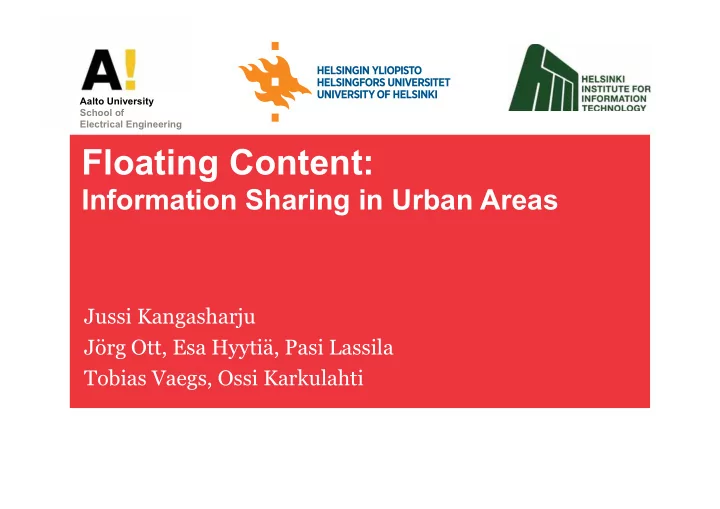

Aalto University School of Electrical Engineering Floating Content: Information Sharing in Urban Areas Jussi Kangasharju Jörg Ott, Esa Hyytiä, Pasi Lassila Tobias Vaegs, Ossi Karkulahti
Infrastructure-less Content Sharing… • Ad-hoc local social network-style information sharing: Digital graffiti w/o servers and infrastructure • Leaves notes, comments, stories, etc. in places • Define reach (area of interest) and lifetime • Leverage delay-tolerant ad-hoc communication between mobile devices for information replication & acquisition Aalto University School of Electrical Engineering
…in Urban Environments?! • Connectivity (to infrastructure) • Location privacy • Content “privacy” • Geographic validity • Temporal validity • User identification Aalto University School of Electrical Engineering
What for? Coupling in location, decoupling in time • Tourists and locals, sharing context information • Going out with friends (bars, theme parks, hiking) Aalto University School of Electrical Engineering
What for? • Ride sharing • Flea markets • Ticket trading • Content sharing • Anything – ephemeral – co-located – loss-tolerant – (time-insensitive) Aalto University School of Electrical Engineering
What’s new? • Similar concepts have been “floating” around – Digital graffiti – At least as early as 2005 on something similar to floating content – Geocasting and other approaches in the late 1990’s • Often limited in scope • Our contribution – Extended notion of floating content [PerCom 2010 WiP] – Analytical modeling [Infocom 2011] – Thorough evaluation of feasibility – Figuring out how to make this work in practice Aalto University School of Electrical Engineering
Floating Model Replication Anchor zone 1 0 r a r r a Deletion 1 Replication range Availability range 0 r a Aalto University School of Electrical Engineering
B Floating Protocol A Beacon A B Beacon Summary ( , , ) ( , ) Request ( ) Request ( ) Simultaneous Beaconing bidirectional continues Summary ( , ) ) operation Aalto University School of Electrical Engineering
Two-Pronged Approach to Evaluation • Analytical modeling – Not really covered in this talk [Infocom 2011] – Different scenarios, different mobility models – Main result: criticality condition • Simulations – Initially simple simulations to test feasibility [PerCom 2010 WiP] – First result: Need 1 person per 50m 2 on average – This agrees with the analytical criticality condition – In this paper: criticality validation + parameter space exploration Aalto University School of Electrical Engineering
Simple Analytical Model: Black Box ν N ν Anchor µ > 1 zone N nodes Criticality condition 1 Sojourn time: µ Aalto University School of Electrical Engineering
Evaluation Setup • The ONE Simulator: 4500 x 3400m simulation area – Helsinki City Scenario – Restless nodes (tourists) • Moving around along shortest paths between points of interest • On foot, by car • Some trams following regular routes – 126, 252, 504 nodes – 10m, 50m radio range – r = a = 200m, 500m Aalto University School of Electrical Engineering
Contact density distribution • Example: 252 nodes, 10m radio a=r=200m a=r=500m Aalto University School of Electrical Engineering
Feasibility Aalto University School of Electrical Engineering
Feasibility: Analytical Model Validation • Tiny messages, de-facto infinite buffer, one location only • Example: 252 nodes, 10m radio, r=a=500m, TTL=1h 10 1 8 0.8 0.6 6 4 0.4 2 0.2 0 0 Criticality value Floating success • Holds equally well for other parameter settings Aalto University School of Electrical Engineering
Feasibility: Floating over time Content sinks early… …or stays around with Floating Lifetime Probablity (M) high probability 1 0.9 P{Message lifetime >= t} 0.8 size dominates Anchor zone 0.7 radio range M 50 (500m,500m) 0.6 over M 10 (500m,500m) 0.5 M 50 (200m,200m) 0.4 M 10 (200m,200m) 0.3 0.2 0.1 0 0.2 0.4 0.6 0.8 1 Fraction of TTL t Aalto University School of Electrical Engineering
Operational Considerations: DoS Aalto University School of Electrical Engineering
Operational Considerations: DoS • Prioritization functions to encourage locality and modesty for replication and deletion – FIFO – RaNDom – Smallest Area First: f(a) – Smallest Volume First: f(a × size) – Small Total resources First: f(a × size × TTL) Aalto University School of Electrical Engineering
Performance characterization • Helsinki City Scenario • Parallel content posted at arbitrary locations – 126 nodes, 50m radio, 2 Mbit/s net data rate – Message rates: 1, 2, 4 messages per node per hour • Mix of floating content messages – Random message sizes: [100 KB … 1000 KB] – TTL [ 30min … 3 hours] – Anchor zones [ 500m … 2000m ] Aalto University School of Electrical Engineering
Findings for 4 Messages/node/hour Aalto University School of Electrical Engineering
Conclusion and Next Steps • Simple, yet appealing geo cooperation model • Workable already for modestly dense scenarios – Simulations agree well with theoretical modeling • Some built-in DoS protection and garbage collection • Probabilistic operation and user acceptance? • More extensive simulation studies • Implementation for Android: real-world experiments Aalto University School of Electrical Engineering
Recommend
More recommend